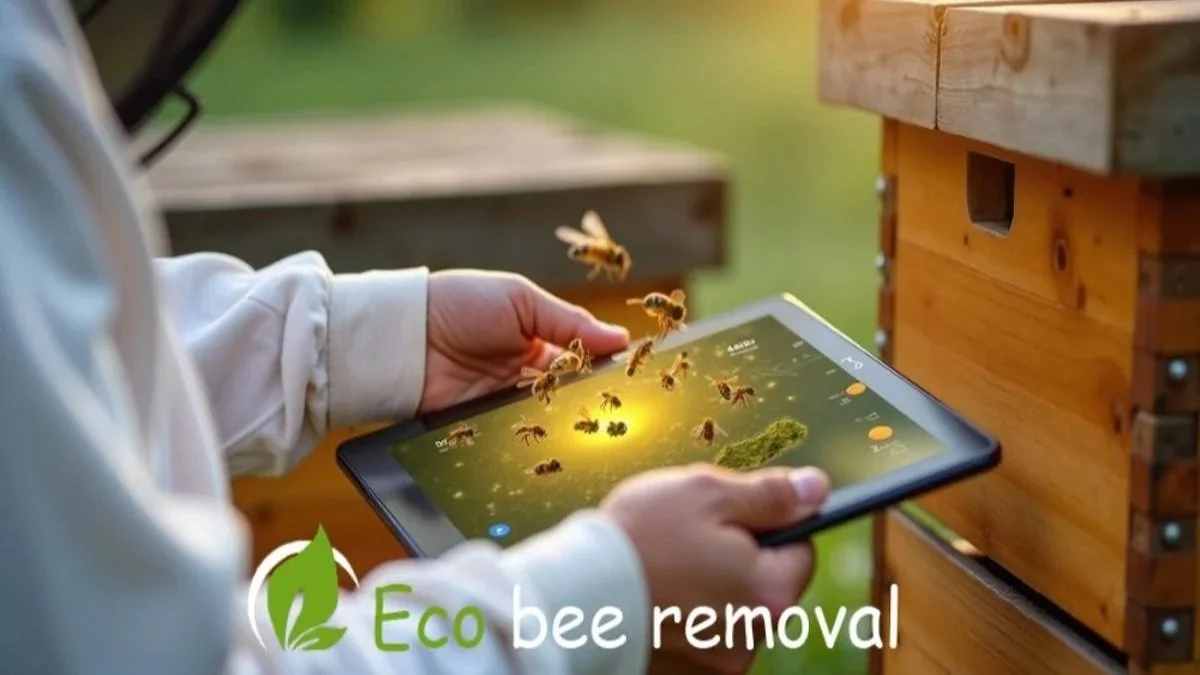Artificial Intelligence in Bee Monitoring & Hive Health.
In recent years, Artificial Intelligence (AI) has been transforming industries worldwide — and beekeeping is no exception. With global bee populations facing serious threats from habitat loss, pesticides, and climate change, beekeepers and environmentalists are turning to technology to safeguard these vital pollinators. AI-powered bee monitoring systems are now helping detect diseases early, analyze hive behavior, and optimize bee colony management — all while reducing human error.
In this post, we’ll explore how AI is revolutionizing hive health, the benefits it brings to sustainable beekeeping, and how this technology is shaping the future of bee conservation.
AI-powered hive monitoring technology used by beekeeper.
What Is AI Bee Monitoring?
AI bee monitoring refers to the use of artificial intelligence, smart sensors, and machine learning algorithms to track and analyze bee activity inside and around hives.
Instead of manually inspecting hives — which can be time-consuming and stressful for bees — AI systems continuously collect data on:
Bee movement and population
Temperature and humidity inside the hive
Honey production and weight
Queen bee activity
Sound and vibration patterns (which reveal hive stress levels)
This data is then processed by AI models that learn to recognize signs of disease, swarming behavior, or stress long before a beekeeper could notice them manually.
How AI Helps Monitor Hive Health
AI-powered monitoring devices combine cameras, microphones, and environmental sensors to gather a complete picture of a hive’s wellbeing. Here’s how it works step by step:
1. Image Recognition & Bee Counting
High-resolution cameras record bee entry and exit activity at the hive entrance. AI algorithms use image recognition to count individual bees, detect abnormal traffic patterns, and identify drones or worker bees.
If fewer bees return than usual, the system alerts the beekeeper to potential colony stress, pesticide exposure, or disease.
2. Sound Analysis
Every bee colony has a unique sound signature. AI microphones detect subtle changes in buzzing frequencies, which can indicate hive stress, queen loss, or swarming behavior.
By analyzing sound waves, AI can determine if the bees are healthy, hungry, or in danger — all without opening the hive.
3. Thermal & Environmental Sensors
Temperature and humidity levels are vital indicators of colony health. AI monitors these environmental factors continuously, helping beekeepers maintain the perfect hive conditions year-round.
For instance, a sudden drop in hive temperature may suggest queen failure, while excess heat might point to overcrowding or poor ventilation.
4. Predictive Health Alerts
AI doesn’t just report what’s happening — it predicts what might happen next.
Machine learning models analyze past data to forecast issues like colony collapse disorder (CCD), Varroa mite infestations, or even honey production trends, allowing for proactive solutions instead of reactive fixes.
Why AI Matters for Global Bee Conservation
Bees are essential pollinators responsible for one-third of the food we eat. Yet, global bee populations have been declining rapidly due to pesticides, habitat loss, and diseases.
AI gives researchers and conservationists the tools to:
Collect massive amounts of real-time data across regions
Identify trends in bee population health
Understand how climate change affects pollination patterns
Build smarter strategies for bee relocation and conservation
This data-driven approach allows environmental organizations to make informed decisions — not guesses — when it comes to protecting bee populations and maintaining biodiversity.
Smart Beekeeping: The Future of Hive Management
AI isn’t replacing beekeepers — it’s empowering them. With smart hive devices and mobile apps, even small-scale beekeepers can now track their colonies in real-time.
Imagine getting a phone notification that says:
“Hive #2: Abnormal vibration detected. Possible queen replacement in progress.”
This kind of remote hive monitoring saves time, reduces human disturbance, and improves overall hive productivity.
Some AI-based tools even offer cloud dashboards showing:
Hive weight trends (to estimate honey yield)
Bee flight patterns
Ambient environmental data
Historical hive performance
These features make AI beekeeping more efficient, sustainable, and less intrusive.
Detecting Diseases Early with AI
One of the most powerful applications of AI in beekeeping is disease detection.
Bees can suffer from several illnesses, such as:
Varroa mite infestation
American foulbrood (AFB)
Nosema disease
AI models trained on thousands of hive images can detect subtle visual cues of infection — such as irregular brood patterns or dead larvae — far earlier than the human eye.
This early detection enables prompt treatment, preventing the spread of diseases to other colonies and saving thousands of bees.
Sustainable and Eco-Friendly Hive Management
AI also supports eco-friendly bee management practices, thereby reducing the need for harmful chemicals and the frequency of hive openings.
Instead of using pesticides indiscriminately, beekeepers can utilize AI data insights to target only the affected hives, thereby minimizing environmental impact.
Moreover, by optimizing hive temperature, humidity, and feeding schedules, AI helps conserve resources and reduce carbon footprints — perfectly aligning with eco-conscious bee removal and relocation services like those offered by Eco Bee Removal.
Sustainable AI-based hive management system for bee conservation.
Real-World Examples of AI in Beekeeping
Several innovative companies and researchers are already using AI to improve hive management worldwide:
BeeWise has developed robotic hives that automatically monitor and treat bees using AI.
ApisProtect uses in-hive sensors to provide real-time alerts about hive conditions and diseases.
Pollenity offers smart monitoring systems for small-scale beekeepers, helping them manage colonies more effectively.
These advancements show how AI is not just a futuristic idea — it’s already revolutionizing the way we protect and sustain bee populations.
The Future of AI & Bee Conservation
As technology evolves, AI will continue to play a crucial role in pollinator conservation. Future innovations may include:
Drones that track wild bee colonies in remote areas
Satellite imaging to monitor global pollination trends
Blockchain systems for traceable, ethical honey production
When combined with community-driven conservation and eco-friendly removal practices, AI could be the key to saving bees for future generations.
✅ Conclusion
The fusion of Artificial Intelligence and beekeeping represents a powerful step toward a sustainable future. From disease prevention and hive health tracking to data-driven conservation, AI is helping humans understand and protect bees like never before.
As an eco-friendly bee removal company, Eco Bee Removal strongly supports technologies that promote bee welfare and environmental sustainability. By integrating smart monitoring tools, we can ensure that every bee relocation is safe, scientific, and successful — for both bees and humans alike.


